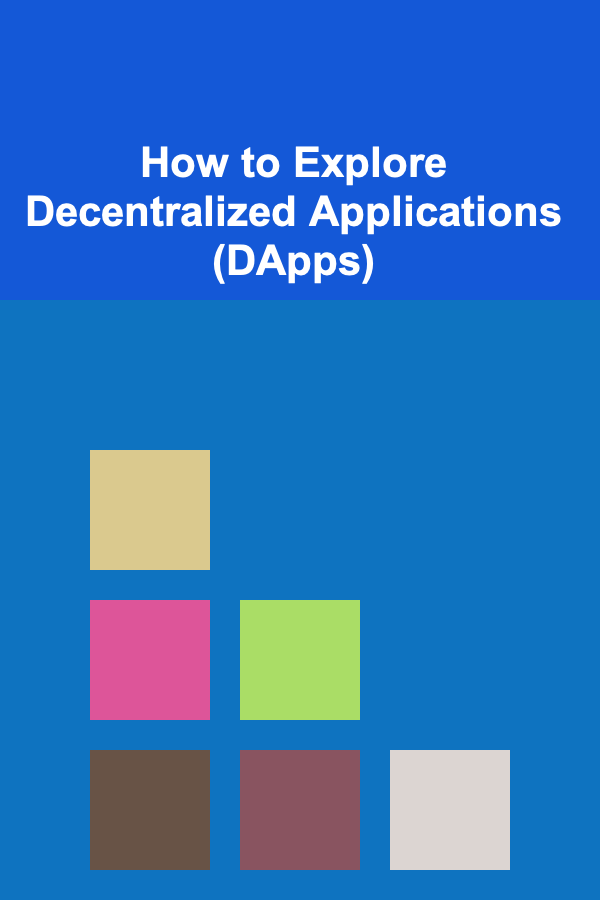
How to Explore Decentralized Applications (DApps)
ebook include PDF & Audio bundle (Micro Guide)
$12.99$6.99
Limited Time Offer! Order within the next:

Decentralized applications (DApps) are a revolutionary concept that has gained immense popularity in recent years. As the world moves towards more decentralized technologies, DApps are playing an essential role in reshaping how we interact with the internet, conduct transactions, and engage in digital services. This guide will help you understand the fundamentals of DApps, how to explore them, and what the future holds for these decentralized applications.
What Are Decentralized Applications (DApps)?
Decentralized applications, or DApps, are software applications that run on a peer-to-peer network, typically utilizing blockchain technology. Unlike traditional applications, which are hosted on centralized servers controlled by a single entity, DApps operate on decentralized networks, providing a higher degree of transparency, security, and user control. These applications leverage blockchain's key features such as immutability, decentralization, and distributed consensus to function effectively.
A key characteristic of DApps is that they are not governed by any central authority, and the data is typically stored on a blockchain, ensuring that no single point of failure can compromise the system. This decentralized nature allows for increased privacy, lower chances of censorship, and a more user-centric approach to application design.
Key Features of DApps
- Decentralization: The primary feature of DApps is their decentralization, which eliminates the need for a central authority. They operate on a network of nodes that participate in the governance and operation of the application.
- Transparency: Since the data and transactions in a DApp are recorded on a blockchain, they are publicly available and can be verified by anyone. This transparency ensures accountability and trust in the system.
- Smart Contracts: Many DApps use smart contracts---self-executing contracts with the terms directly written into code. These smart contracts automatically execute transactions when predefined conditions are met, making them essential to the functioning of many DApps.
- Immutability: The data stored on a blockchain is immutable, meaning it cannot be altered or tampered with once it has been added to the chain. This feature is crucial for ensuring the integrity of transactions and other data in DApps.
- Open Source: Most DApps are open source, allowing anyone to inspect, modify, or contribute to the code. This open nature promotes innovation and collaboration within the decentralized ecosystem.
- Tokenization: Many DApps integrate cryptocurrencies or tokens into their functionality, providing incentives, rewards, or governance mechanisms within the application. These tokens can be used for various purposes, such as paying for services or voting on protocol changes.
Exploring DApps
Now that we have a basic understanding of DApps, let's explore how to get started with them. This section will guide you through the steps of discovering, interacting with, and exploring decentralized applications.
1. Understanding the Types of DApps
DApps can be broadly categorized based on their use cases. Understanding these categories can help you navigate the vast world of decentralized applications. Some of the most common types of DApps include:
- Decentralized Finance (DeFi): DeFi applications provide financial services without the need for intermediaries such as banks. These DApps allow users to lend, borrow, trade, and earn interest on cryptocurrencies. Examples include Uniswap, Aave, and Compound.
- Decentralized Exchanges (DEXs): DEXs are platforms that allow users to trade cryptocurrencies directly with one another, without relying on a central exchange. Examples include Uniswap, Sushiswap, and PancakeSwap.
- Non-Fungible Tokens (NFTs): NFT DApps allow users to create, buy, sell, and trade unique digital assets, such as art, music, or collectibles. Prominent NFT platforms include OpenSea, Rarible, and Foundation.
- Gaming DApps: Decentralized gaming applications offer players the opportunity to engage in blockchain-based games where in-game assets and tokens are owned by the players. Examples include Axie Infinity and Decentraland.
- Decentralized Social Media: These platforms provide a decentralized alternative to traditional social media, enabling users to share content, interact with others, and participate in governance without relying on a centralized authority. Examples include Steemit and Mastodon.
- Decentralized Autonomous Organizations (DAOs): DAOs are organizations that are governed by smart contracts, where decisions are made through token-based voting by members. Popular examples include MakerDAO and Aragon.
2. Selecting a Blockchain Network
DApps can be built on various blockchain networks, each offering different features and capabilities. Some of the most popular blockchain platforms for DApp development are:
- Ethereum: Ethereum is the most widely used blockchain for DApp development. Its robust smart contract functionality and large developer community make it a popular choice for building decentralized applications.
- Binance Smart Chain (BSC): Binance Smart Chain is a fast and low-cost blockchain that has gained popularity for hosting DeFi DApps. BSC is known for its scalability and its ability to support high-throughput applications.
- Polkadot: Polkadot is a multi-chain blockchain platform that enables different blockchains to communicate and share data. Polkadot's interoperability makes it a unique option for building cross-chain DApps.
- Solana: Solana is known for its fast transaction speeds and low fees. It has become a popular choice for building high-performance DApps, particularly in the gaming and DeFi spaces.
- Avalanche: Avalanche is a high-throughput blockchain that focuses on providing scalability and low fees. Its consensus mechanism allows for fast finality and is ideal for DApps requiring quick and secure transactions.
- Tezos: Tezos is a self-amending blockchain that allows for on-chain governance and formal verification of smart contracts. It is a preferred platform for projects that prioritize security and sustainability.
3. Finding DApps to Explore
Now that you have an understanding of the different types of DApps and blockchain networks, the next step is to find DApps to explore. Several platforms and websites track and categorize DApps, making it easier to discover new applications. Some of the most popular DApp discovery platforms include:
- State of the DApps: State of the DApps is one of the most comprehensive directories for decentralized applications. It allows users to filter DApps by category, blockchain, and activity level.
- DappRadar: DappRadar tracks the performance of DApps across multiple blockchains, providing insights into user activity, transaction volumes, and other key metrics.
- DeFi Pulse: DeFi Pulse is a popular platform for discovering DeFi-related DApps. It provides real-time data on the top DeFi projects, including information on liquidity, TVL (Total Value Locked), and token performance.
- CoinGecko DApp Section: CoinGecko, a popular cryptocurrency data aggregator, also features a section dedicated to decentralized applications. Users can explore DApps by category and blockchain.
- DApp.com : DApp.com is another directory for discovering DApps, with an emphasis on gaming and entertainment applications. It also provides information on user metrics and rankings.
4. Interacting with DApps
Interacting with DApps is relatively straightforward, but there are a few steps you need to follow. Here's a simple guide on how to interact with DApps:
Step 1: Set Up a Cryptocurrency Wallet
To interact with most DApps, you'll need a cryptocurrency wallet that can store your digital assets and interact with the blockchain. Some of the most popular wallets for DApp interaction include:
- MetaMask: MetaMask is a browser extension wallet that supports Ethereum and other blockchains compatible with Ethereum's Virtual Machine (EVM). It's one of the most popular wallets for accessing DApps.
- Trust Wallet: Trust Wallet is a mobile wallet that supports multiple blockchains and tokens. It's an excellent choice for interacting with DApps on your mobile device.
- Coinbase Wallet: Coinbase Wallet is a non-custodial wallet that lets you interact with decentralized applications and store a variety of cryptocurrencies.
- Ledger: If you prefer hardware wallets for added security, Ledger devices work with many DApps by connecting through MetaMask or other browser wallets.
Step 2: Connect Your Wallet to the DApp
Once your wallet is set up, you'll need to connect it to the DApp you wish to explore. Typically, DApps will have a "Connect Wallet" button that will prompt you to select your wallet provider (e.g., MetaMask, Trust Wallet). After selecting the wallet, you'll need to approve the connection, allowing the DApp to access your wallet's address.
Step 3: Explore the Features of the DApp
Once connected, you can start exploring the DApp's features. Depending on the application, you might be able to interact with the platform by:
- Transacting: If you're using a DeFi DApp or decentralized exchange, you can perform transactions like swapping tokens, providing liquidity, or earning interest.
- Minting and Trading NFTs: In NFT marketplaces, you can mint, buy, or sell digital assets.
- Participating in Governance: Some DApps, particularly DAOs, allow users to vote on proposals or protocol changes using governance tokens.
Step 4: Keep Track of Your Activities
It's essential to monitor your transactions and activities while interacting with DApps. Most wallets provide a transaction history, and DApp explorers allow you to track specific actions on the blockchain.
5. Security and Privacy Considerations
While DApps offer many advantages, it's crucial to stay vigilant when interacting with them. Some essential security and privacy tips include:
- Use Hardware Wallets: For large amounts of assets, consider using a hardware wallet for added security.
- Check Smart Contract Audits: Before interacting with a DApp, verify if its smart contracts have been audited for vulnerabilities.
- Beware of Phishing Attacks: Always double-check the website URL and avoid clicking on suspicious links.
- Maintain Privacy: Be cautious about sharing personal information when using DApps. Since many DApps are decentralized, your actions may not be as anonymous as you think.
The Future of DApps
The future of DApps is bright, with increasing adoption and innovation. As blockchain technology evolves, DApps are likely to become more integrated into our daily lives. The potential for decentralized applications spans various sectors, from finance and governance to entertainment and gaming.
Conclusion
Decentralized applications are changing the way we interact with the internet and digital services. With their decentralized nature, transparency, and security features, DApps provide a promising alternative to traditional, centralized applications. By understanding how to explore and interact with DApps, users can unlock the full potential of decentralized technology and participate in the decentralized future of the internet. As blockchain adoption continues to grow, DApps will only become more integral to our digital lives.

How to Create a Themed Recipe Book for Special Occasions
Read More
How to Decorate Your Front Porch for a Welcoming Holiday Look
Read More
How to Detox Your Body Safely for Weight Loss
Read More
How to Leverage Robo-Advisors for Automated Investment Growth
Read More
How to Make Your Own Natural Pest Control
Read MorePetty Cash Reimbursement Tracker: A Step-by-Step Guide
Read MoreOther Products

How to Create a Themed Recipe Book for Special Occasions
Read More
How to Decorate Your Front Porch for a Welcoming Holiday Look
Read More
How to Detox Your Body Safely for Weight Loss
Read More
How to Leverage Robo-Advisors for Automated Investment Growth
Read More